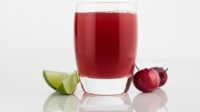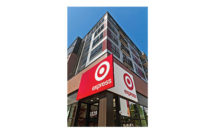Healthier Beverages Keep Developers Busy
Ingredient suppliers weigh in on current industry trends
Participants in Beverage Industry’s ingredient supplier roundtable had much to say about
product development and trends, particularly in functional and nutritional
beverages. Like many in the industry, these ingredient specialists have
observed the trend toward “healthier” beverages that provide
benefits such as heart health, weight management and energy through
nutrients, antioxidants and vitamins. But with all these
“extras,” consumers still want products with flavor that tastes
top of the line. Authentic and ethnic flavors such as exotic fruit and
floral tastes continue to be a driving purchase factor.
This year’s panel included: Pam Stauffer, marketing programs
manager at Cargill Health and Food Technologies, Minneapolis; Debby Poskanzer, senior manager, consumer insights, and Erik Donhowe, director, beverage
applications, at Wild Flavors,
Erlanger, Ky.; Diane Hnat, senior marketing manager, DSM
Nutritional Products
Inc., Parsippany, N.J.; and Maureen Draganchuk, vice president,
business development, and Anton Angelich, group vice president, marketing, at Virginia Dare, Brooklyn, N.Y.
Q: What are the most important beverage trends you
have observed in 2005?
Pam Stauffer: Consumers
continue to address health concerns with fortified beverages.
Nutritional beverages are becoming more customized by designing
health for specific use-occasion, health concern and age demographics.
Debby Poskanzer and Erik Donhowe: We have to mention the flurry of activity in diet drinks
across so many categories (soft drinks, energy drinks, as well as lower
calorie fruit drinks and dairy drinks for kids). Functional beverages
continue to be on a big up-swing, because consumers are really interested
in wellness and want to address health concerns. This will continue,
because the baby-boomers are getting older and they represent a quarter of
the nation’s population. There has also been an extension of high
growth rates of RTD coffee into 2005.
The extreme popularity of energy drinks has resulted in
continuing high growth rates. We have seen an extension due to a broadening
of the energy drink category into more diverse flavors, and energy drinks
into other categories such as enhanced waters.
The media has been reporting a decline in low-carb as a
trend, and sustainable diet. However, in the beverage arena, most of the
low-cal offerings are also, naturally low in carbs, so the declining trend
may not be true. These beverages just aren’t being ‘marketed’ as low-carb. Where we do see a decline is with the
100-percent juice category. Parents are looking for lower calorie
‘healthy’ options for their children.
Diane Hnat: ‘One
Upping’ on energy drinks is still in vogue. Besides the name and the
packaging, a few new ingredients are hitting the beverage scene such as
CoQ10 and EGCG, for example.
Although some of the beverage marketers are not focused
on using GRAS ingredients there are definitely new ingredient entries with
new purported health benefit promises being introduced every day. Watch for
olive leaf extract for joint health very soon.
Also milk drinks continue to be innovative. With 26
states having introduced legislation in 2005 to curtail unhealthy snack
vending sales in schools, milk is a natural entry because it’s
already healthy. Marketers are making it
‘healthier’ with higher percent daily values of B vitamins and
vitamin E particularly. Strict no-carb/low-carb products have dwindled.
Fortified smoothies are increasingly popular, especially with prebiotics.
‘Beauty from within’ is a growing trend
… or call it cosmeceuticals. The vitamin E, biotin and pantothenol in
your shampoo and lotion translate to a spectacular low-calorie water
beverage with vitamin E, biotin and pantothenate, at the very least. There
is a great interest in skin health with boomer women, also wishing they
could see borage or evening primrose in those beverages too. In
supplements, these are linked to skin health.
Maureen Draganchuk: Some of the top growing trends include an increased focus
for improved nutrition through the use of added vitamins and minerals,
reduced ‘sugar calories,’ a larger number of fruit- and
vegetable-based drinks and more flavored milks/ soymilks/smoothies.
Tea-based beverages also continue to grow such as red, white and green teas
with new interest in Matcha and Kombucha teas, as well as juice teas, tea
sodas and nectar teas. The industry is also seeing an increased number of
‘un’ sweet tea varieties and not just diet products.
Additionally, there are more flavored waters and more alcoholic beverages
with many unique flavor profiles to choose from.
Q: What issues are product developers dealing with
this year?
Pam Stauffer: Product
developers in the beverage industry address formulation issues associated
with incorporating health promoting ingredients into beverages.
Cargill Health & Food Technologies offers a host of ingredients
that are easy to incorporate into beverages without negatively affecting
taste and texture – such as Prolisse soy protein isolate,
Oliggo-Fiber inulin, CoroWise plant sterols and OptaFlex chondroitin.
Debby Poskanzer and Erik Donhowe: Of course the sucralose shortage was a
challenge, but beyond that, we believe beverage developers are still
learning how to fortify and formulate with functional ingredients. This
requires a great deal of complexity and developers will need to work very
closely with suppliers to avoid negative interactions, color changes,
processing issues, and off-notes in their products.
Additionally, functional beverages have more complex requirements for
batching and scale-up (from concept to production run), and they require
extensive product stability testing.
Diane Hnat: Product
developers want to put more oily-based nutrients in beverages but continue
to search for stable dispersible non-ringine forms. Emulsions are the best
bet from carotenoids to omega-3 long-chain fatty acids. Wild Flavors and
Blue Pacific have some outstanding ingredients, as far as utilizing their
technologies to incorporate such nutrients.
Maureen Draganchuk: Product
developers still face the continued challenge of making lower-calorie
beverages taste like full-calorie counterparts. Making beverages taste and
appear as if they contain dairy also is challenging. Many processors cannot
use dairy materials in their plants and don’t want to use dairy
because of allergen concerns.
Developers are also challenged with making highly
fortified meal replacement beverages taste like a non-fortified
counterparts, too. For example, making an Ensure-type product taste like a
Starbucks Frappuccino and with minimal cost is a great endeavor. Clients
are also asking for their artificially sweetened beverages to taste as if
they were sugar sweetened. The industry has come a long way, but demands
are even higher in this area.
Additionally, consumers want more naturally colored
beverages, which create the challenge of matching artificially colored
beverages with natural colors (many of which do not exist yet) and with the
same degree of stability. Continually generating new flavor ideas and
profiles that will be both authentic to the normal consumer and still be
acceptable to other markets is always in the top of most developers’
minds. A good example is a true mango profile for the Latin market that
will be acceptable to all other consumers.
Q: In what product category are you seeing the most
innovation? Please give examples?
Pam Stauffer: The
industry is doing a good job of reducing calories while maintaining great
taste in beverage applications.
Debby Poskanzer and Erik Donhowe: We have to acknowledge the yogurt drink and smoothie category.
What an overwhelming amount of fun, new, healthy product choices and
flavors have been introduced from GoGurt to
Dannon Light & Fit Smoothies, Stoneyfield Juice Smoothies, the Nouriche
products, and DanActive.
Another very innovative beverage category is the recent
interest in functional alcohol beverages, in particular the energy alcohol
drinks. These require the same complexity as non-alcohol energy drinks,
with the added regulatory restrictions imposed by the Alcohol and Tobacco
Tax Bureau.
We’d really like to see some of this innovation
in the hot beverage categories. Other than Starbuck’s Chantico, we
haven’t seen many attempts at anything exciting.
Anton Angelich: There
is noticeable innovation in the beverage industry in the area of sweetener
systems. Product developers are requiring taste solutions that bring
non-caloric sweeteners closer in taste to sugar.
Also with the proliferation of consumer interest in
natural and organic products, we are seeing more and more products in the
marketplace. Along with this, there is greater competition amongst products, and greater taste expectations. In the
past, many wellness products would be accepted for their health
benefits. Today, they must have more than that. They must taste good, and
must be appeal to a wider consumer audience.
Q: Looking into the future, what trends and/or
concerns do you see on the horizon?
Pam Stauffer: Consumer
demand for healthier, great-tasting convenient products continues to grow.
Manufacturers need to address health concerns that are most relevant to
today’s consumers such as heart health, joint health, bone health,
weight management and diabetes.
Debby Poskanzer and Erik Donhowe: We definitely expect continued growth in functional foods and
beverages. Along with this, we see a lot in individual specificity –
anything from gender-based
drinks, ailment-specific drinks, the burgeoning area of nutigenomics, etc.
It seems that authenticity, is something that consumers are also starting
to desire such as authentic Hispanic/Latin flavors true to character, with
the ‘right’ impact and sweetness, or exotic fruit and floral
notes that are authentic and identifiable.
Diane Hnat: As some of
the HealthFocus/DSM Nutritional Product Inc. customized consumer research
showed in 2003, a growing trend will be ‘gut’ or glycemic index
health. People aren’t hesitant to talk about it anymore. As yogurts
morph into more drink and smoothie offerings, ‘active cultures’
are expected. Ingredient suppliers need to provide stable versions,
second-generation probiotics, if you will. As well, smoothies and yogurt
drinks are showcasing prebiotics and soluble fiber magnificently.
Anton Angelich: The part
that beverages play as an integral part of daily food intake
requirements/recommendations will be a major influence on the industry in
the future. New beverage products that fit within school nutrition
programs and meet the consumer’s interest in fiber and whole grains
will continue to develop and evolve. As more and
more scientific information about the nutritional benefits and risks (and
often contradictory information) about various ingredients and products
reach the consumer via the media, a situation of
“consumer-hyper-information- nutrition-download” will prevail.
The constantly changing information on what is good for you and what is not
– will create confusion, misinformation and uncertainty in purchase intent. BI

